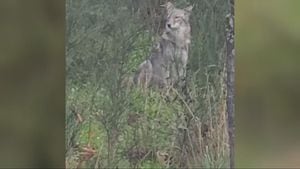Residents of Seattle’s Queen Anne neighborhood are increasingly concerned about frequent coyote encounters, particularly after a recent incident in which a woman was bitten while trying to save her dog from a coyote attack near Kerry Park. The growing sightings and aggressive behavior of coyotes have prompted individuals like Rachel Alves, a long-time resident, to express her worries about the rise in coyote activity. She noted that after a series of encounters, it feels like coyote interactions are becoming the new normal in her area. Alves recounted an experience where a coyote approached her, initially appearing friendly, further raising the alarm about their proximity and unusual boldness.
Alves shared a video highlighting her experience when she spotted a coyote at David Rodgers Park. In the footage, she attempted to scare the animal away, but the coyote displayed intelligence by waiting patiently for pedestrians to cross. She described how the coyote approached a couple walking nearby, indicating its lack of fear towards humans. The increasing frequency of these encounters has left residents questioning what measures they should adopt to protect themselves and their pets from potential harm.
Jeff Patterson, another resident of Queen Anne, echoed Alves’ sentiments about the changing dynamics of human-coyote interactions in the area. Having lived in the neighborhood for two decades, Patterson noted a significant uptick in coyote sightings and their apparent indifference to human presence. He experienced a close call himself while with his corgi, Falcor Stubbins, who were curious about each other. Patterson expressed concern that this behavior illustrates a potential for escalation in coyote aggression, stating, “If it happened once, it can happen again.”
The Washington State Fish & Wildlife Police (WDFW) provided guidelines to the community regarding safe practices when encountering coyotes. They emphasized the importance of not running away, advising individuals to remain standing, maintain eye contact, and assertively shout at the animal to establish dominance. Furthermore, they encouraged residents to make loud noises, throw objects, and use hoses as deterrents if coyotes approach too closely. The guidance aims to promote safe interactions and mitigate risks for both wildlife and residents.
Overall, the heightened presence of coyotes in Queen Anne has sparked significant unease among its residents, who are increasingly alert to the potential danger they pose. As more accounts of aggressive coyote behavior surface, locals like Alves and Patterson share their encounters and caution others to be vigilant when in outdoor spaces. With the support of wildlife authorities, the community is exploring various strategies to deal with this unexpected wildlife challenge, seeking a balance between coexistence and safety.
As the situation develops, residents remain on edge, hoping that increased awareness and adherence to safety advice will help prevent further incidents. Each encounter serves as a reminder of the expanding reach of urban wildlife and the need for proactive measures to ensure both human safety and wildlife preservation. The Queen Anne neighborhood now finds itself at a crossroads, where the allure of nature intertwines with the challenges of urban living, highlighting the intricate relationship between humans and the environment.

